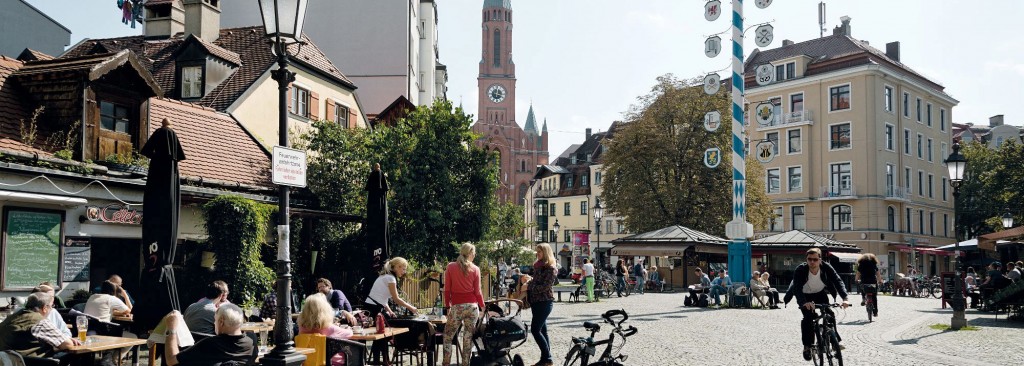Heidhausen

Heidhausen is considered the second Schwabing. Trendy bars and beautiful Art Nouveau houses have transformed the former working-class neighborhood into an exclusive neighborhood that is popular with both students and affluent clients with high expectations.
Heidhausen is a comfortable and sought-after fashionable district with many leisure activities, but it is also a very quiet residential area. Because it is not as lively and lively as Gärtnerplatz or as active as Schwabing, you will find something that is close to your heart.
Heidenhausen’s sidewalks are rich not only with cafes, patisseries, restaurants and eateries for every taste and budget, but also fashionable boutiques and jewelry stores. Music lovers often visit this neighborhood because it’s home to the Gasteig Cultural Center with several concert halls and the Moffatwerk Cultural Center, a beautiful old industrial building from the late 19th century on Isar Island.
The historic center of the neighborhood, fortunately, was not too damaged by the bombing during World War II, which is especially gratifying for lovers of ancient architecture. The famous “French Quarter” of Heidhausen, next to the Place de Paris, is also not to be missed. The streets around the square were named after the Prussian army’s battles with the French.
Along the embankment of the Isar River stretches picturesque park, named after the Bavarian King Maximilian, one of the most romantic places in the city, beautiful at the time of the gentle awakening of nature in spring, and in the green noise of summer, and the snowiness of winter.In the northern part of the neighborhood is the legendary Villa – Museum Stuck, designed by its owner, “the king of painters” Franz von Stuck, – a unique creation of the master in the Jugend style.
Only the Isar terrace on the hilltop separates Heidhausen from the center of Munich to the east. The district borders with Bogenhausen to the north and Au to the south. The area is not only beautiful, it is also very livable: numerous subway lines, the U 4 and U 5 subway lines and the U 5 light rail lines that pass through the Ostbahnhof give Heidenhausen a perfect connection with the rest of Munich and the surrounding suburbs, which can be reached very quickly and conveniently.
Together the districts of Au and Heidenhausen form Munich’s 5th district, which has a total area of 421.96 ha and a population of approx. 60,756. The municipality is well served by public transport since there are 87 kindergartens, 7 elementary school, 3 lower secondary schools, 3 secondary schools, 4 gymnasiums and 18 vocational schools.
Au
Munich’s Au district is primarily a residential area that has a reputation as one of the coziest historic parts of the city. It stretches along the picturesque waterfront of the Isar River. Traditions and customs are preserved here with love and care. This is evidenced by popular festivals such as the Starkbierfest on Nockherberg (brewery festival, a highly esteemed tradition in Bavaria) and the Auer Dulten fair on Mariahilfplatz, which take place every year in Au and are very popular with locals and visitors.
The phenomenon of the Au district is that it does not conform to stereotypes: You’re in the heart of a city of millions, but the hectic pace of metropolitan life certainly doesn’t pulsate here.
The big streets like Breiteranger or Quelenstrasse are home to many old-timers who appreciate and support the traditions and customs of the place where they were born and grew up. The Franz-Prüller Strasse is unique in the way it is; if you walk here you take a trip back in time, because not much has changed since the 19th century.
Popular destinations in Au include Columbus Circle, Nockhenberg and Olmüller Strasse. And the neighborhood around Gertnerplatz is one of the city’s stylish modernist landmarks. There is never too much noise, you can have breakfast in one of the cozy cafes, and with the first signs of springtime sunshine, residents and visitors alike enjoy the warmth of the open-air terraces of the restaurants and patisseries.
The Schweigerstrasse, which leads from the Cornelius Bridge, is characterized by more modern buildings. By early 2016, new residential buildings for 1,500 apartments had been built on the site formerly owned by the Paulaner brewery.
Munich’s Nockherberg is a kind of distinct culture. Every year, after the carnival, a keg of strong beer is uncorked at the Paulaner beer houses and the traditional Derbleken (mockery of the social order) is performed. Bavarian public figures and federal politicians are mocked.
